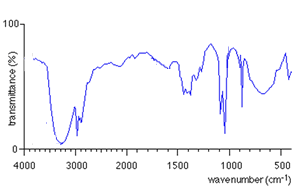Below is a table of some typical covalent bonds and their characteristic wavenumber at which energy is absorbed.
Bond
type |
Type
of molecule found in. |
Wavenumber |
C-O |
Alcohols
and esters |
1000-1300 |
C=O |
Carboxylic
acids and esters |
1680-1750 |
C=C |
Alkenes |
1600-1700 |
C-H |
Alkanes |
2850-3100 |
C-H |
Alkenes |
3000-3100 |
O-H |
Carboxylic
acids |
2500-3300 |
O-H
|
Alcohols |
3200-3600 |
Consider the IR spectrum on the right. Taking the wavenumbers above into account, discuss if this spectrum belongs to an alcohol or a carboxylic acid.
If it was a carboxylic acid
we should see troughs at the wavenumber :
- 1680-1750 corresponding to the C=O bond;.
- 2500-3300 corresponding to the O-H bond;
- 1000-1300 corresponding to the C-O bond.
We certainly see troughs corresponding to the C-O and O-H bonds but not
the C=O. We therefore assume we have an alcohol rather than a carboxylic
acid.
Should the trough at 3400 or 2950 be used to determine if the compound is an alcohol or an acid? Discuss.
No the trough at 2950 is due to the C-H bond which is present in both alcohols and acids as is the O-H bond represented by the trough at wavenumber 3400.
